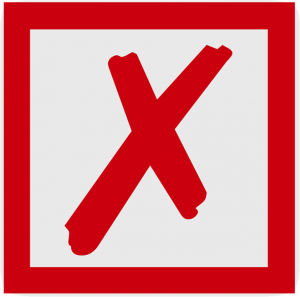We’ve been offering a resume editing service since 2008. In this time, we’ve had the fortune to work with thousands of clients, and have repeatedly come across some common mistakes in consulting  resumes we've had the pleasure of reviewing.
resumes we've had the pleasure of reviewing.
Below is a list of the 5 more common resume mistakes we’ve noticed. You can also refer to the previous post: Top 10 consulting resume mistakes.
[optin-monster-inline slug="v0fyaufg0zbvzbjgitwn"]
1. Overly small font for your name
Your name at the top of the resume should be 18 pt or 20 pt font; bold font is optional and depends on the font you are using. Your name is the most important part of your resume, since you want recruiters to remember who you are.
Also, make sure the name you use is exactly the same in all communications, including your cover letter and emails. This is sometimes a problem for those with both an official name in their mother language and another unofficial name in English.
2. Getting “creative”
Some people feel like they need to express creativity in order to get the job. While this is sometimes true, the risk of looking unprofessional almost always outweighs any potential benefits of looking creative.
Make sure that you do not:
- Use colors or shades of gray. You should use only black and white
- Include pictures or icons
- Use unconventional fonts such as Comic Sans
Don’t worry about not being able to express creativity in your resume. The interview is a better time to prove your creativity.
3. Imperfect date/location alignment
In Microsoft Word, if you need to align part of the text on a line to the right, like the date of a work experience, do not just use a bunch of spaces or tabs. Either use tables or right-aligned tabs. Aligning by just pressing the space bar several times will invariably produce dates that are not aligned correctly; even if it’s off by half a space, it will be noticeable.
4. Using overly technical terms
Did you use a Maxwell-Boltzman distribution to help model the in vitro effects of anti-mitotic drugs on endometrium cells? It doesn’t matter if you understand this; it matters if the recruiter can understand it. Keep jargon to a minimum unless it’s something that an average consultant can understand (e.g. saying you used CRM software is fine). You should rephrase what you did so that it’s understandable and make sure any reader can see why it was significant.
For example, the above example might be re-written as “Modeled effect of an anti-cancer drug on human cells using advanced statistical methods, resulting in 40% more accurate cancer cell growth predictions and $50,000 additional budget allocation for drug research.”
Using too much technical jargon will mean that you lack the communication skills necessary to interact with a diverse array of people that you would meet in a consulting career. One way to double-check your resume is showing it to a friend outside your current field or industry and seeing if, for each bullet point, they can understand:
1. What you did
2. Why what you did was significant.
One caveat to the above: you also don’t want to make your description overly simplified. As an extreme example, “Conducted biology experiments using math” would be almost meaningless.
5. Creating overly long lists (of any kind)
As a consultant, you will definitely need prioritization skills. Making overly long lists of any kind is a big no and shows that you don’t know how to prioritize. Usually, this overwhelms the reader, and it will also be unclear which list items are more important and which are less important.
For example, you should not:
- List out 15 different software packages you know how to use. Instead, you should reduce this list to under 8 items (preferably less) by picking the ones you are best at, or the ones you think are considered valuable skills.
- List out 5 different scholarships you received. Instead, you should highlight the one or two most important scholarships, their selectivity, and how much in funds you received in total.
- List out 10 different points under one work experience without sub-bullets. You should delete the less important points and optionally expand on the more important ones, or move some points to be sub-bullets under other related bullet points so that your resume looks more organized.
- List out 8 different student clubs you were involved with. It’s impossible that you were able to contribute significantly to every one of them. Instead, explain more about the clubs where you demonstrated leadership, teamwork, and initiative. It’s OK to list out 2 or 3 clubs in the Additional Information section if you don’t have space for them in the rest of your resume.
Want your cover letter and resume to stand out from the crowd? Work with our expert team on resume edits and let us help you nab that magical offer with the firm of your choice.